This month as part of the venture, we continued with the tasks required to be in a position to test the twin Viper jet engines for our jet hydroplane Longbow (and her spare engine). For those of you who have been following our progress in the monthly updates, you will remember how Craig Bain of Task Pro came to our aid last month, to kindly provide us with the electrical units and purpose made leads, to generate the spark that will ignite the jet fuel in each of our Viper gas turbine engines. Following on from that our next issue was to source female electrical cannon plugs that would perfectly match the threaded 24 pin and 10 pin male connectors on the top of each engine.
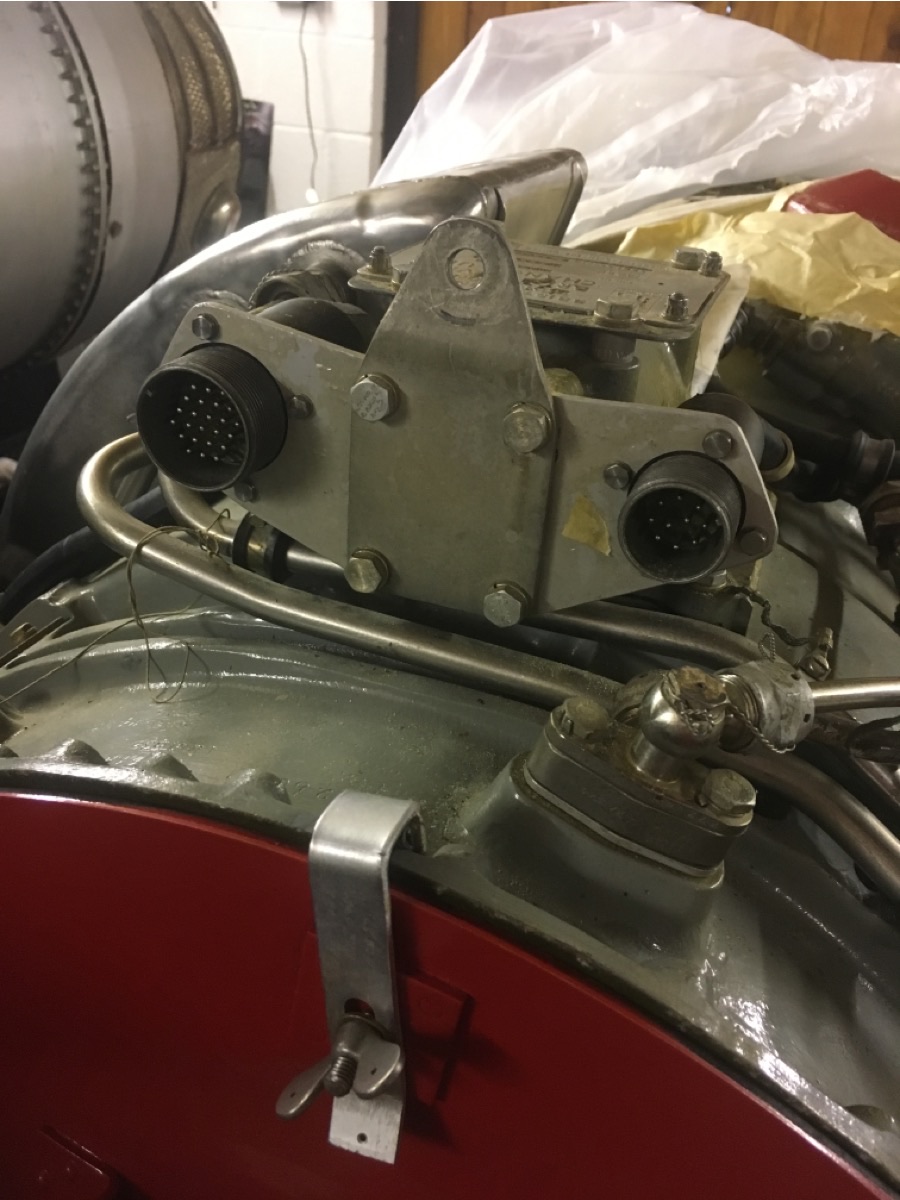
These multi pin electrical connectors relate to providing information from the jet engines to the various gauges and warning lights in the cockpit and also they carry electrical signals instructing the metering system on the jet engines to provide an additional amount of fuel that is required upon start up. There are literally hundreds of variations of these connectors used for many different applications and the manuals for the engines that we have did not provide us with part numbers; so finding the matching canon plugs was causing us some head scratching to say the least.
Fortunately Rene Redmund in New Zealand, who runs Viper jet engines and who was trained and worked upon them in the Royal New Zealand Air Force, came to our aid with part numbers for the connectors and a terrific amount of guidance specific to the Vipers, along with friendship, all of which has been invaluable.
Now that, with the kind help of Rene, we knew the part numbers to the cannon plugs, it was a case of tracking down the actual connector plugs. To this end we have been so very lucky in having RS Components, the UK’s leading supplier of electrical, electronic and industrial components, come on board with the venture as a product sponsor to supply exactly the right connectors we were looking for and the multi core electrical wiring necessary for all three engines.
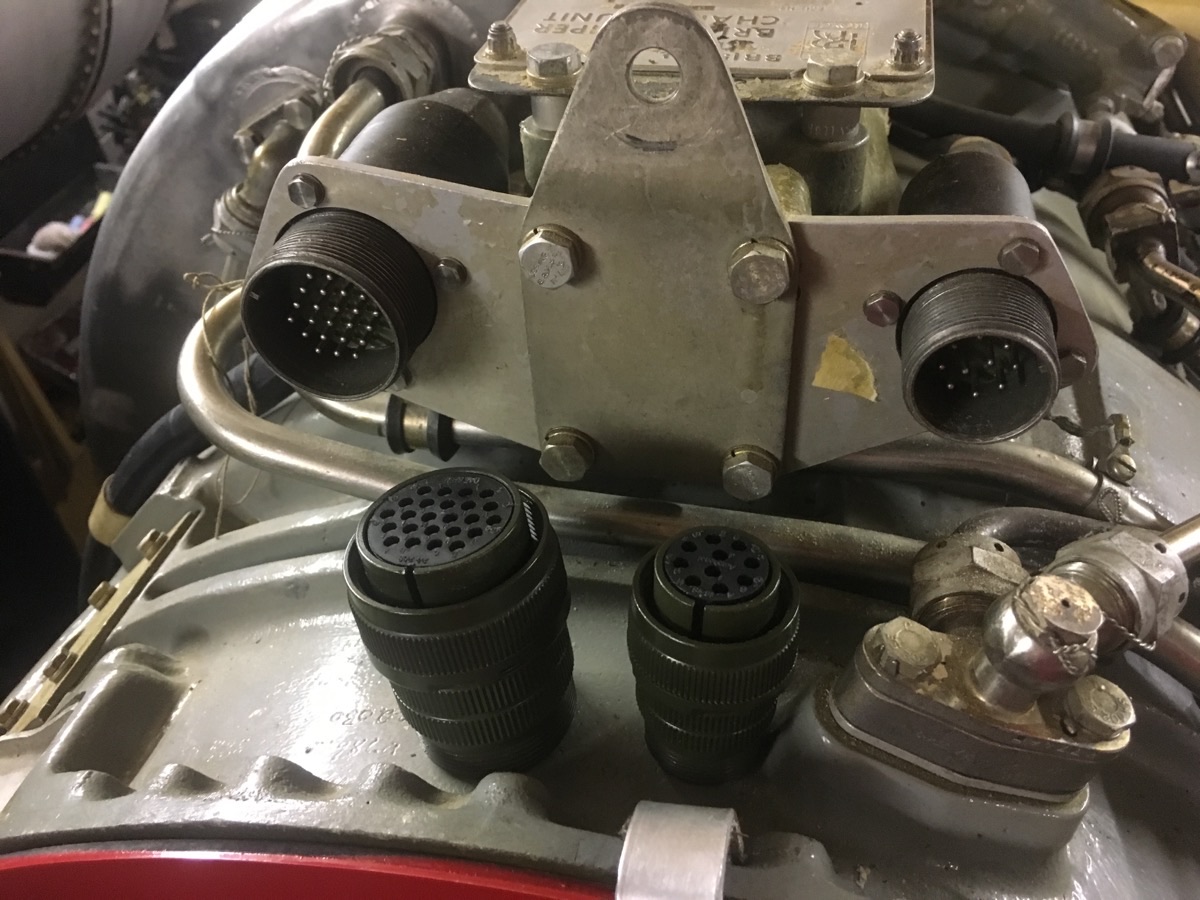
Having solved that little puzzle our attention moved to the electrical starter motors for the jet engines which also once the engines are running, acts as a generator to provide electrical power for the aircraft. In our case given the comparatively minimal run time that we will be out on the lake we should not require the generator output and should be able to use batteries on board as a total loss to power the gauges etc.
In the aircraft this starter motor for the jet engines is itself provided with sufficient electrical power from an auxiliary power unit (APU), either on the aircraft itself, or in a small trolley brought to the aircraft and plugged in until the engines are running. As we don’t have access to such an APU and even if we had one, we are mindful of the significant additional weight of such within the boat, our thoughts turned to providing electrical power to the starter motors through a battery pack supply.
We started the Orpheus jet engine on the Bluebird replica K777 from batteries and likewise the Orpheus on Dave Warby’s Spirit of Australia II jet hydroplane is similarly started from batteries, as are a host of other jet engine drag cars. However in our specific case, just to make things even more complicated, we need to start two jet engines in Longbow one after the other, then turn both of those engines off at the other end of the lake a few miles away to refuel, then re-start both of those jet engines to come back down the course.
For those with all their fingers on one hand, counting those starts adds up to a minimum of four required. The next thing to consider is how we let the electrical starter motor which is rated at standard aircraft voltage of 28v DC and 300 amp, see all that power from the batteries.
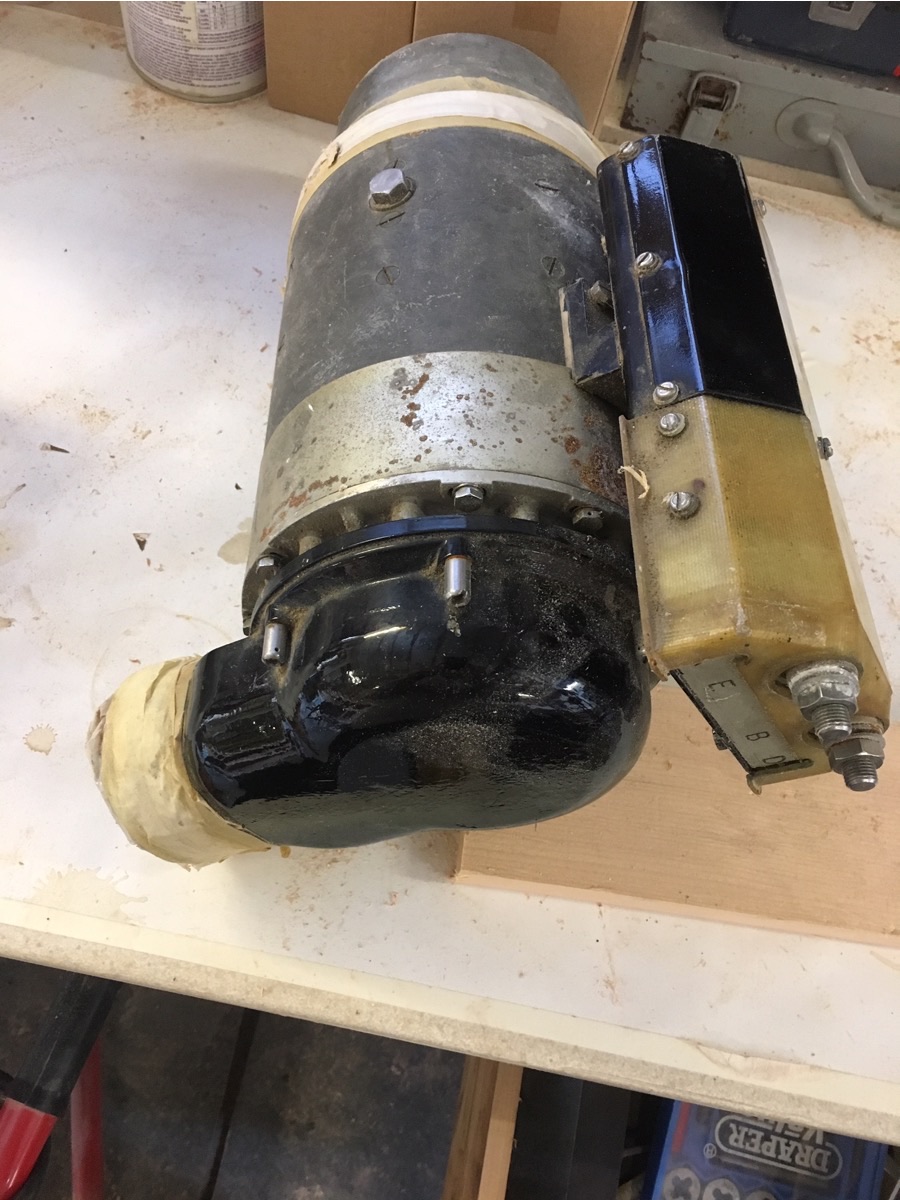
Some projects use a bank of 12v and sometimes 6v DC batteries and with heavy duty solenoids / contactors, they manually step up the voltage or just hit the starter with 24v DC. One of the problems with doing this is the starter and in turn the jet engine that have been quite happily sat still, are given a sudden and aggressive kick up the backside demanding rotation. That in turn puts a shock load down the delicate starter and engine components, which were never designed to see such a sudden jolt. Not surprisingly the risk is that sooner or later we end up with a broken part in either the starter motor or jet engine that would be difficult and expensive to replace and everyone stood around at the lakeside wondering why we cannot run the boat.
Not only that, using the above method, the batteries get asked to give their very best in one sudden spike and by all accounts even though the starter motor is only rated at 300 amps, the initial draw on the batteries doing it this way to spin all that stationery jet engine using just solenoids / contactors will be around 1000 amps. As you might imagine that amount of current tends to suck the life out of the batteries in no time at all.
We also have to bear in mind that when we start a jet engine we need enough power in the bank to continue cranking that engine on the starter motor well beyond the initial introduction of fuel and lighting it. This is because we need to have lots of cooling air moving through the engine to prevent the temperature of its components being exceeded and consequentially failing through a ‘hot‘ or ‘hung start’.
From past experience we would be lucky to get more than three engine starts with just using solenoids / contactors to introduce the starter motor to all the power the batteries have to offer. This may not be an issue if say you are running a jet engine drag car with just one engine where it fires off down the track in a one way run. However for us it is a headache with twin jet engines needing starting at one end of the lake and then restarting both of those engines again at the other end.
Another issue is that unlike a jet car which sits stationery through the start sequence and is held that way by the driver applying the brakes until everyone is clear and ready to go; when we start one of our jet engines in Longbow out on the lake, it generates thrust even at idle rpm and as a consequence the boat will begin to move. Being hooked up to a tender boat for starter batteries whilst we start the second jet engine with Longbow then dragging the tender boat along, could become interesting to say the least.
So ideally we would like a minimum of four jet engine starts from one set of batteries on board the boat without flattening the batteries completely. Taking advice from a number of sources the answer to this appears to be in the form of a DC motor controller that you can program to feed power from the batteries, to the starter motor in a much more civilised way and then disengage once the jet engines are safely up to idle rpm. From what has been suggested, this should give us in the region of 7 starts from a set of batteries before they need to be re-charged which if true would be ideal.
Now where could we get a DC motor controller of suitable capacity, that we could ask to come on board as a product sponsor and help with starting of our twin Viper jet engines in Longbow? The answer came in the form of Steve Smith and his company 4QD that are based in Cambridgeshire, who have so very kindly supplied us with their DC motor controllers and the following photograph shows Steve making up one of their controllers for us.
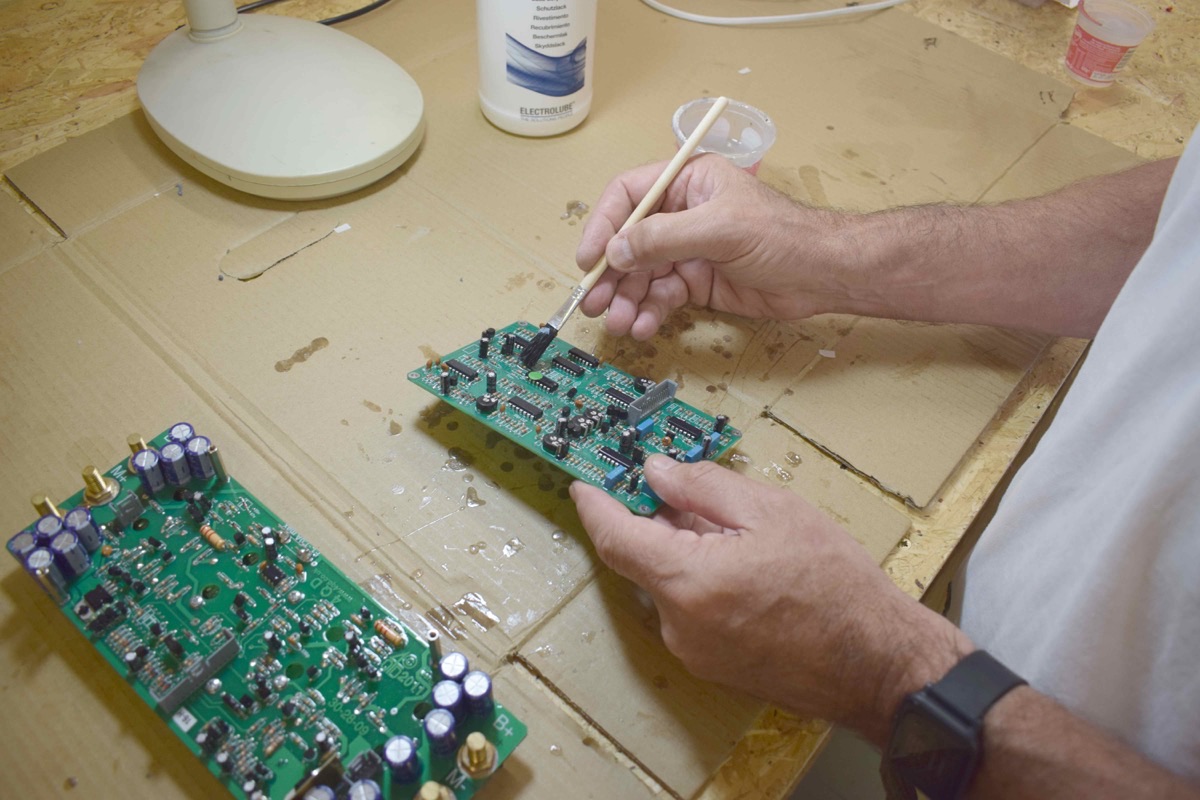
It is a mind boggling amount of electrical components within their controller and my initial thoughts were a concern as to whether the unit would be tough enough to withstand the buffeting of a jet hydroplane running for an Outright World Water Speed Record. However Steve assures us that their units are more than up to the job, having been subject to far worse shock loads in many other applications, including within some of the contestants vehicles in the television series Robot Wars.
Helping us bring all of this together is Paul Jewell, who designed and built the starting system for David Tremayne’s Viper powered ‘Stay Gold’ British jet car. Paul has very kindly come on board with our venture and is working with Steve of 4QD, my good friend John Fielding who is an electronics engineer, Rene our Viper specialist as mentioned previously in New Zealand and gas turbine engineer Tim Paget of our sponsor Aerodot, along with the students of Blackpool & Fylde College who are also sponsoring the venture.
It is all early days yet and there is still an awful lot to do before we can trial the engines in a test rig but we are, thanks to some very kind and very bright assistance beginning to bring it all together and will report back on progress with regards to our jet engines in due course.
In other news our good friend Dave Warby and his team have attended the Big Boys Toys festival in Australia with Spirit of Australia II and as you can see Dave appears to be fully recovered from his broken arm we reported on last month and clearly back to his charming old self.
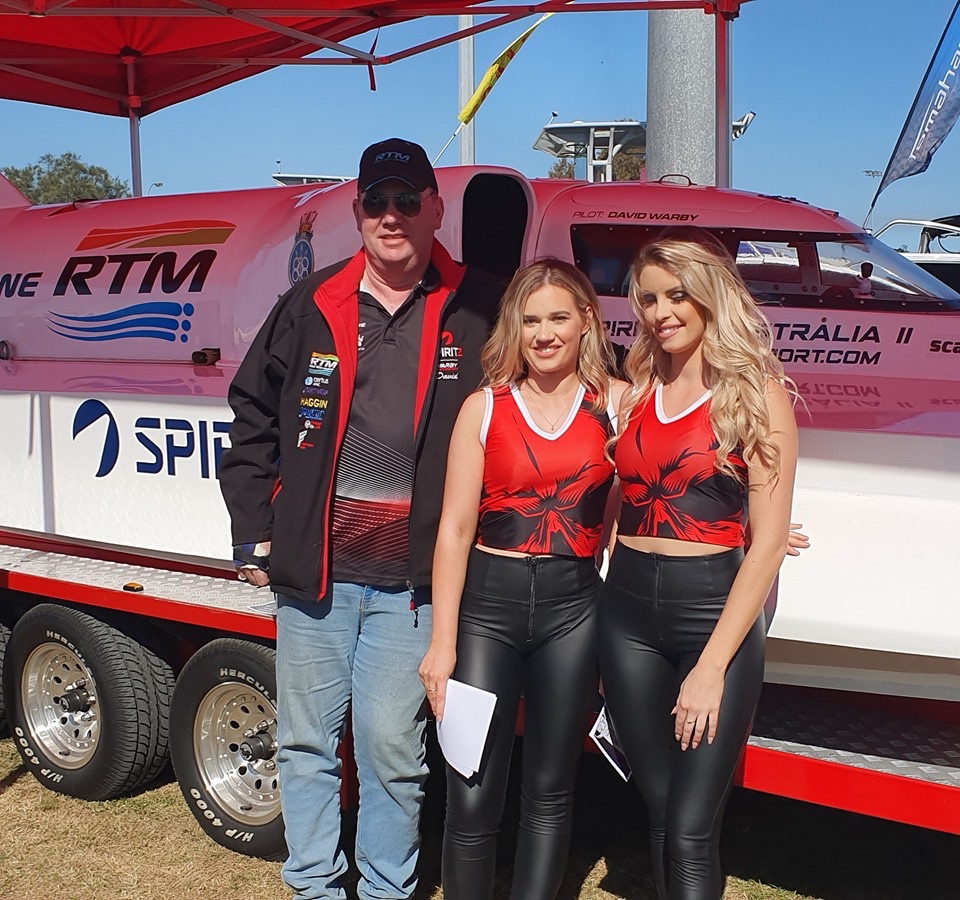
Dave’s tired Orpheus turbine wheel that we reported on last month arrived with us from Australia this month, so we can now send him the replacement wheel that we sourced from the sectioned display Orpheus engine at Hartlepool College, on loan from the North East Aircraft Museum, then take Dave’s turbine wheel up to Hartlepool to go into the display engine.
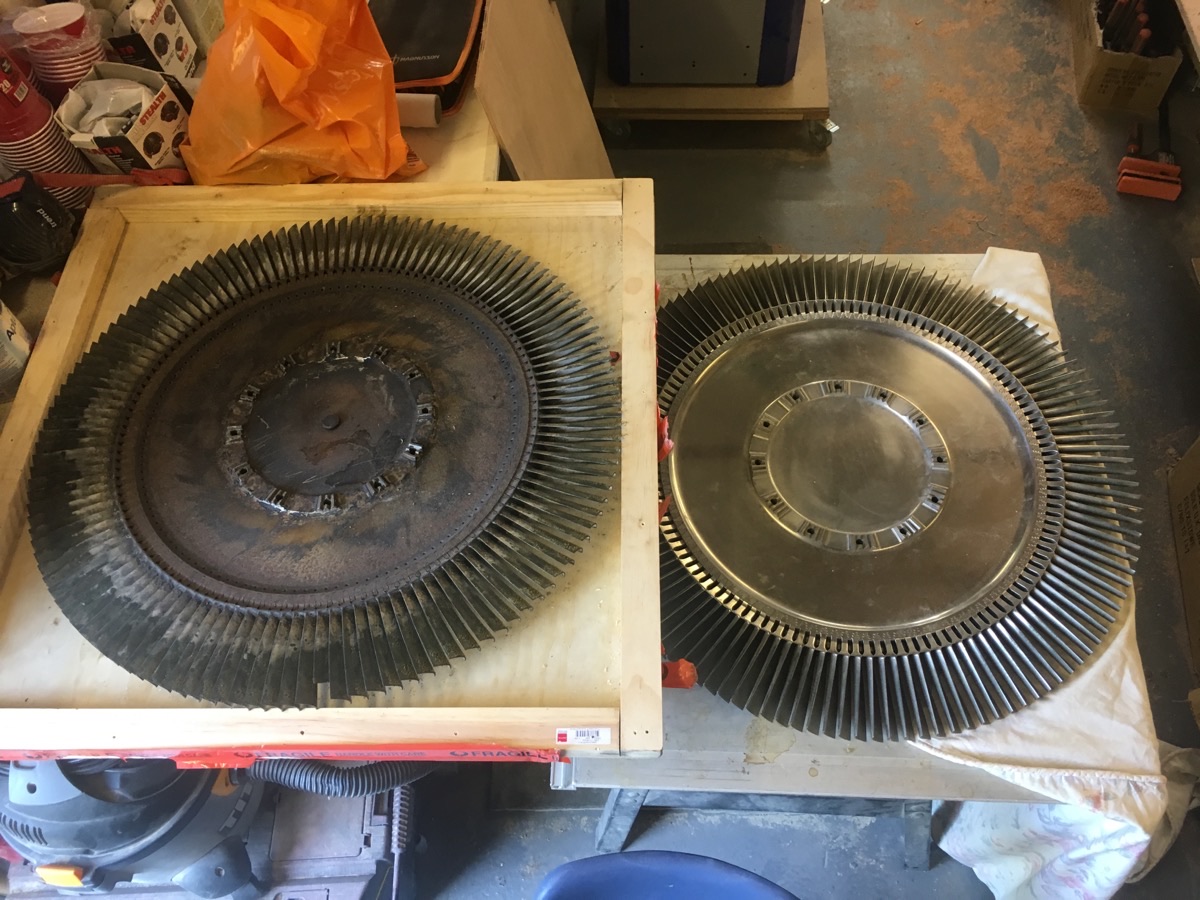
We wish Dave and his team every success in their next round of tests with Spirit of Australia II at Blowering Dam in Australia at the end of this month / beginning of September. Dave reports that the reservoir has filled up nicely since the last time he was there which should allow for better lengths of water to run the boat at speed and we will report back to you on how they get on in next month’s update.
Back with Longbow despite the summer holiday season we managed to bring the team together to bring the hull out of the workshop and turn her over then put her back on the build table. Helping us in the task was Jack Ramsay from Hodgson Academy, Poulton, who came along with his dad to see these crazy guys in Thornton Cleveleys building a jet hydroplane in their home workshop. Jack was clearly inspired by it all and cannot wait to see the jet engines started when we have everything in place, so we must be doing something right. That is apart from whoever lined the tyres up this time to rest the hull on, made it more of an assault course as we walked her out trying not to fall over but drinks all round on completion were very well deserved and a big thank you to all those who assisted.
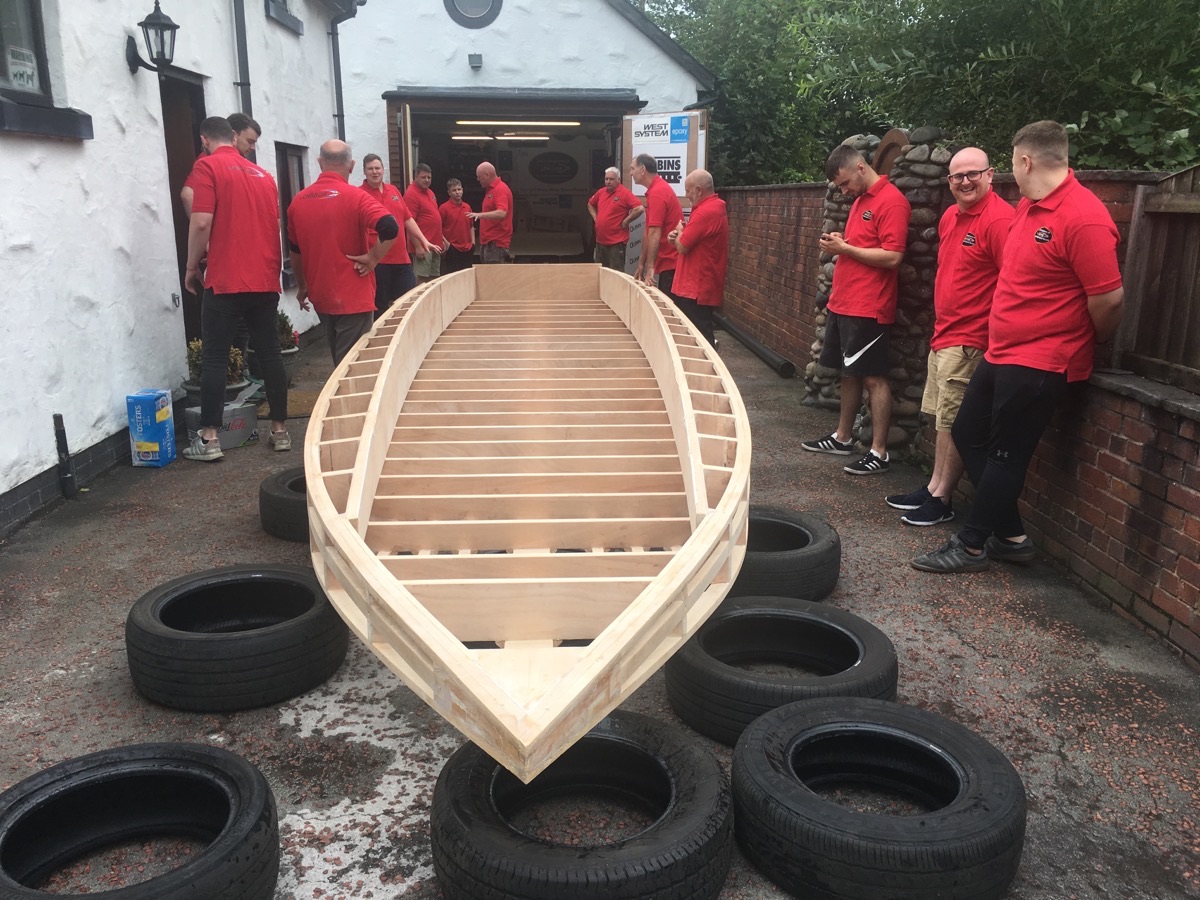
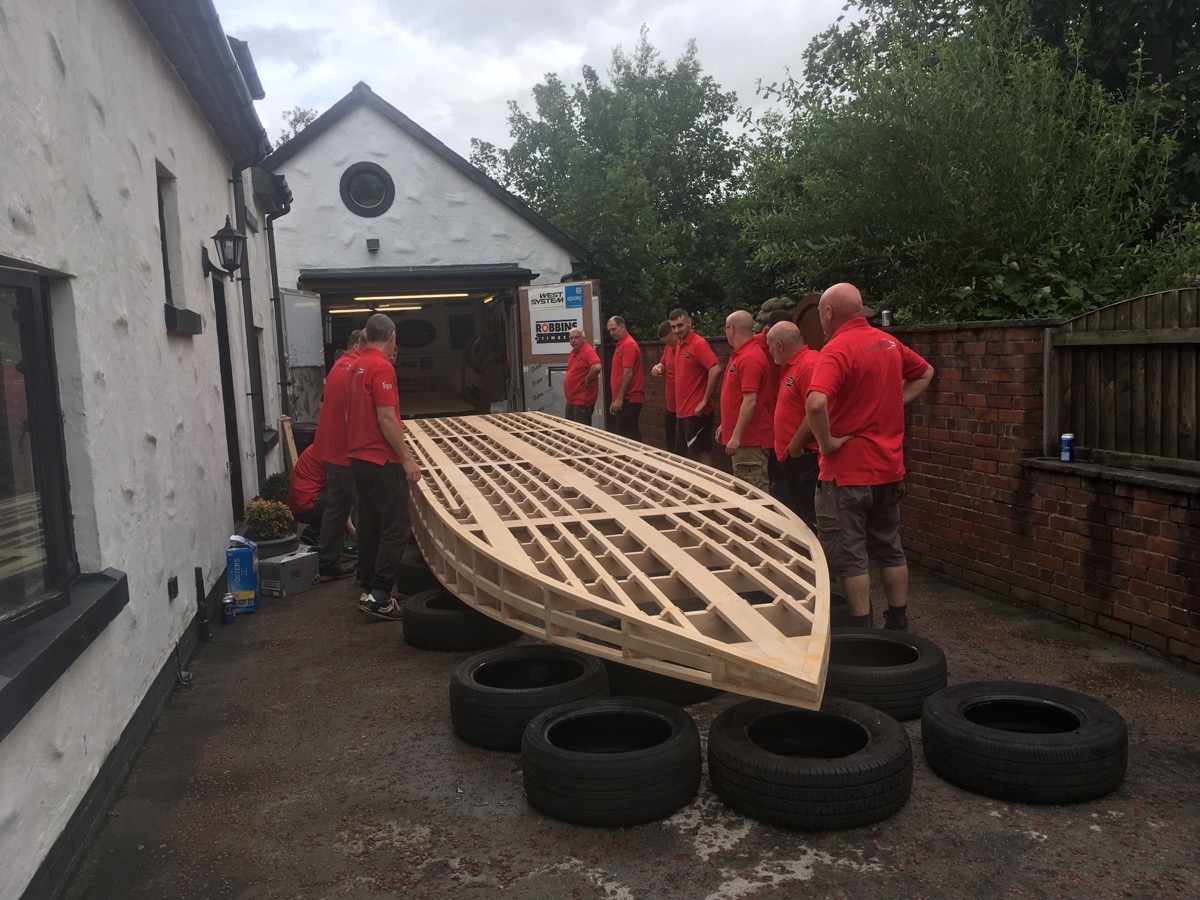
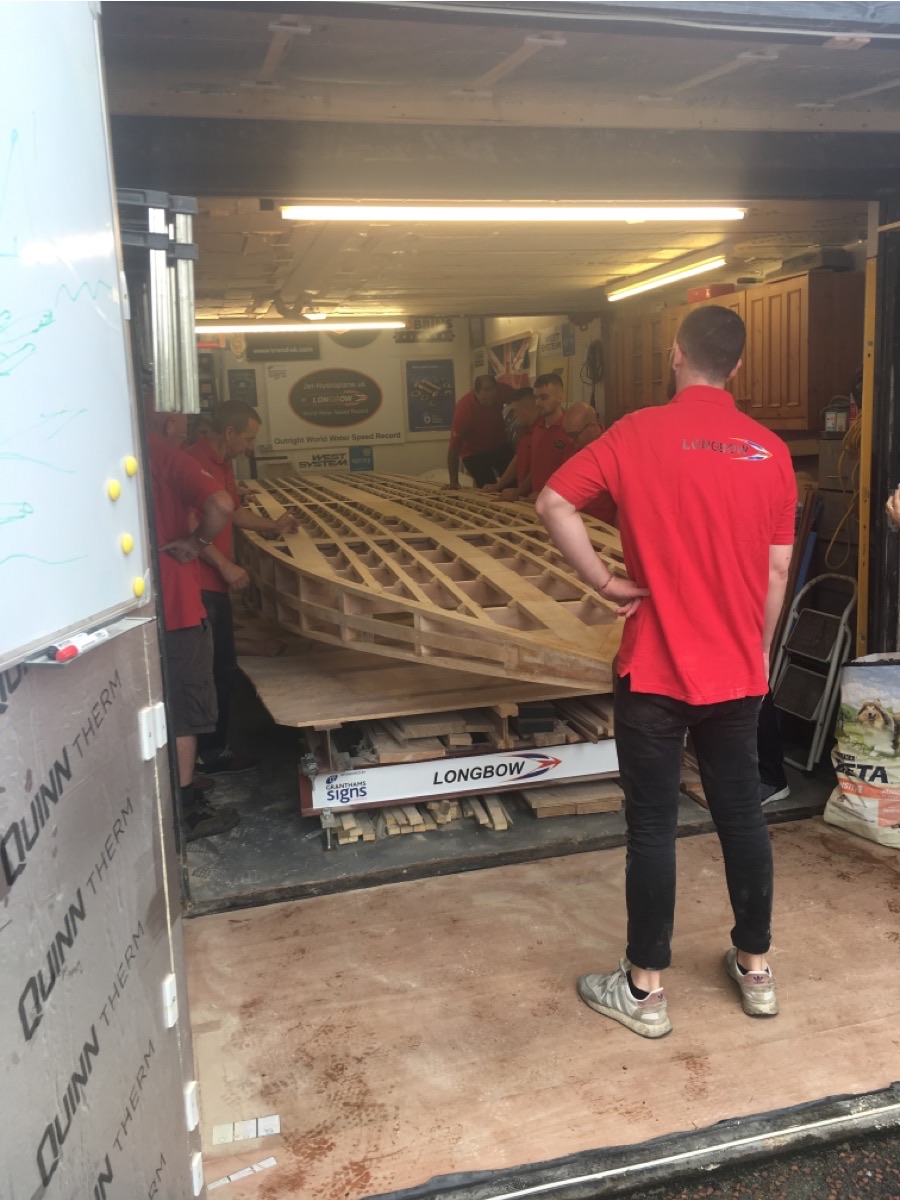
With the hull of Longbow now inverted we can begin cutting to size and forming the scarf joints of the marine grade plywood to the sides of the hull initially as a dry fix to ensure that everything comes together as it should, prior to fixing these elements supplied by our sponsor Robbins Timber using West System epoxy, supplied by another of our sponsors Wessex Resins.
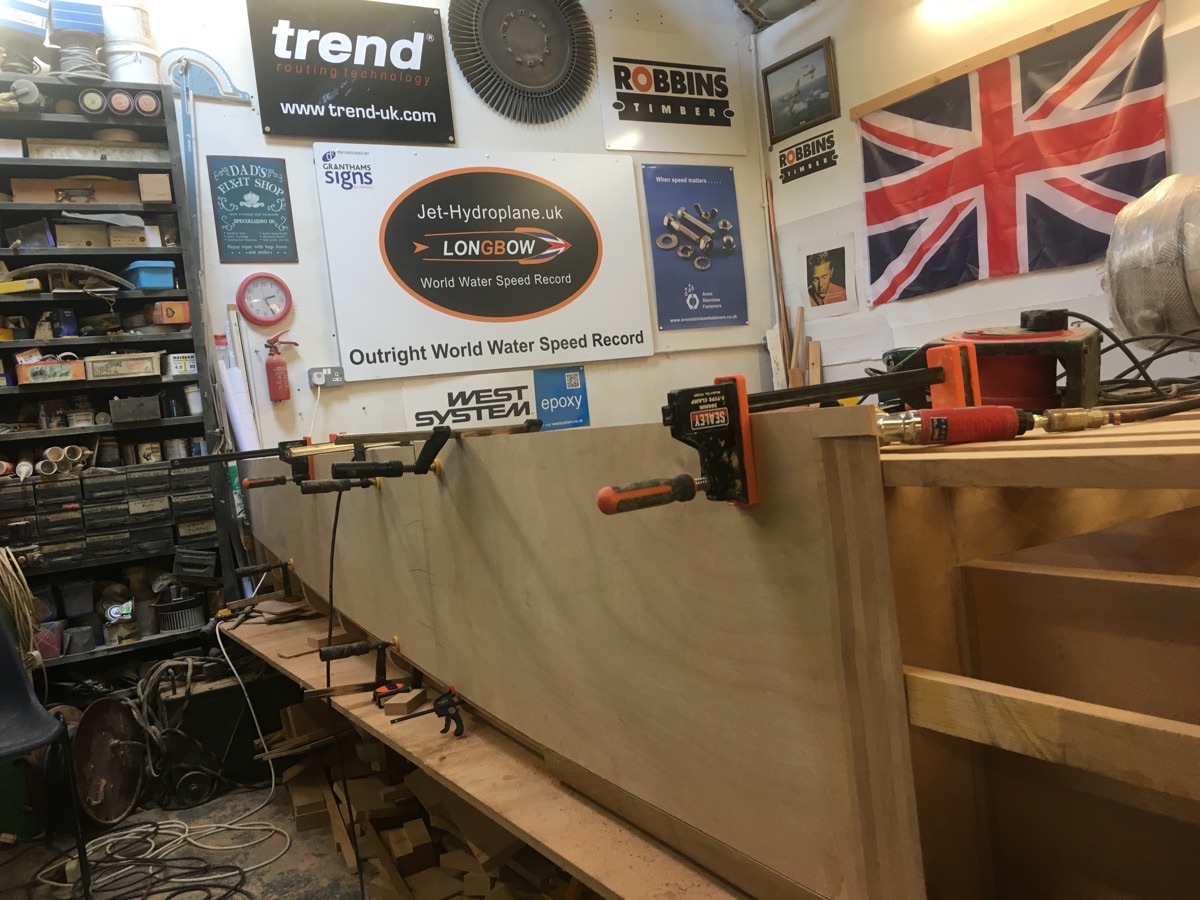
Apologies for not being further along with this dry fix during August but I took a week off with the family on holiday and then Steve our joiner did likewise the following week, so along with the students at Blackpool & Fylde College who are assisting we have all had a fair bit of relaxing downtime this month. Also the lifting frame for the jet engines should have been finished this month but we did a bit of a redesign, so that has delayed manufacture but hopefully it will not be too long before it is with us.
Thank you for tuning in, if you have not done so already, please take a moment to like our Facebook page and we hope to see you again next month for the next instalment of this British attempt upon the Outright World Water Speed Record.
